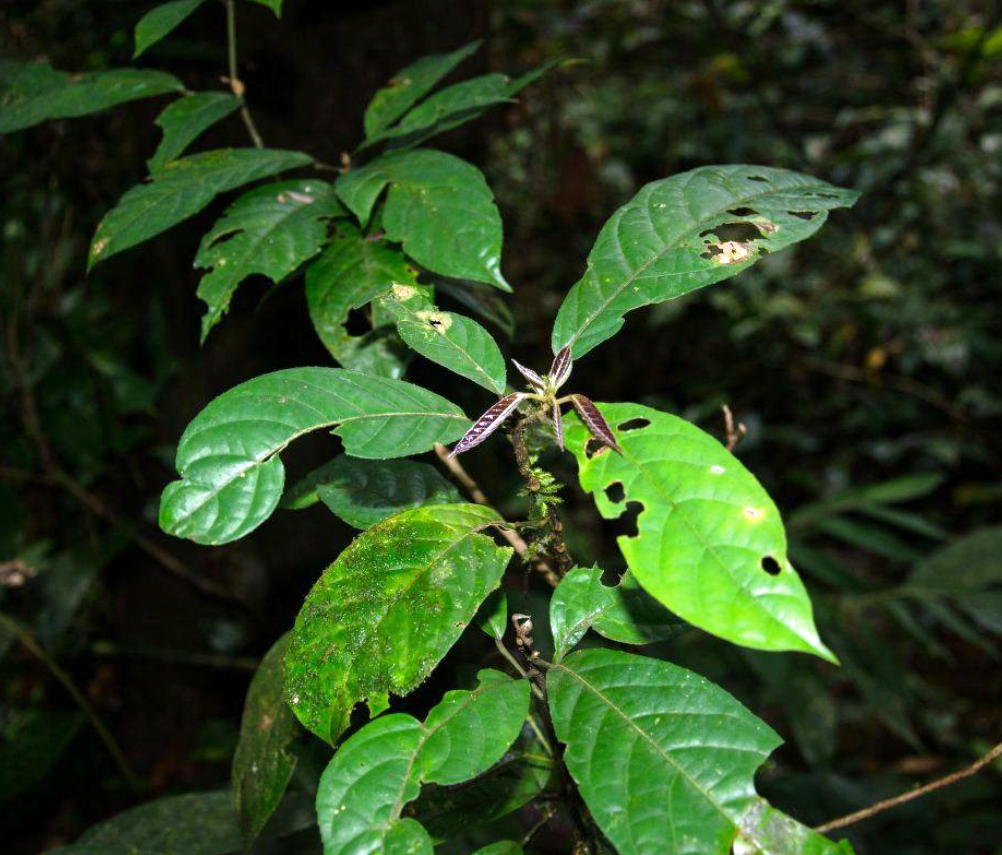Maesobotrya barteri

|
|
Maesobotrya barteri Common Names: Bush cherry, African cherry,
Tongue-staining berry Scientific
Classification Kingdom: Plantae Clade: Tracheophytes Clade: Angiosperms Clade: Eudicots Clade: Rosids Order: Malpighiales Family: Euphorbiaceae Genus: Maesobotrya Species: M. barteri Synonyms: Maesobotrya barteri (Baill.) Hutch. Morphological Description Maesobotrya barteri is a broad-leafed, evergreen shrub or small tree, typically
2–10 meters tall, with a spreading canopy. Its key characteristics include: · Stems: Slender, woody, glabrous to slightly pubescent, often
reddish when young. · Leaves: Alternate, simple, elliptic to obovate (5–15 cm × 3–7 cm),
with entire margins, glossy green, leathery, and slightly serrated (Hutchinson
& Dalziel, 1958). · Flowers: Small, white to pale yellow, 3–5 mm diameter, in axillary or
terminal panicles; 5 petals, fragrant; flowering from January to March. · Fruit: Succulent berries (1–2 cm), black-purple when ripe, edible,
tongue-staining; fruiting from April to June; seeds ovoid, 5–8 mm, with a thin
testa (Ogbuagu, 2008). Distribution and Habitat Maesobotrya barteri is native to West and Central Africa, thriving in humid
tropical environments: · Geographic Range: Found in Nigeria (e.g., Abia, Cross
River), Sierra Leone, Ghana, Ivory Coast, Cameroon, and Liberia; extends to
Central Africa (e.g., Gabon, Congo) (Kew Science, n.d.; Burkill, 1985). · Habitat: Grows in lowland rainforests, secondary forests, and forest
edges; prefers moist, well-drained loamy soils (pH 5.0–6.5) with 1,500–3,000 mm
annual rainfall; occurs at elevations up to 1,000 m (Hutchinson & Dalziel,
1958). · Ecological Role: Provides shade in forest understories;
berries consumed by birds and mammals, aiding seed dispersal; supports
pollinators (bees). Ethnopharmacology Maesobotrya barteri, known as bush cherry, is widely used in West African traditional
medicine, particularly in Nigeria and Ghana, for its antimicrobial, analgesic,
and hepatoprotective properties. Its pharmacological potential is driven by
over 20 identified bioactive compounds, with studies validating several
traditional uses. In African
ethnomedicine, particularly among Igbo, Yoruba, and Akan communities, Maesobotrya barteri is used for: · Infections: Leaf decoctions treat skin infections, sore throat, and
dysentery in Nigeria and Ivory Coast. · Pain and Inflammation: Leaf pastes relieve headaches, arthritis,
and muscle pain in Ghana. · Liver Disorders: Leaf infusions manage jaundice and liver
ailments in Nigeria (Neuwinger, 2000). · Diarrhea: Leaf extracts treat diarrhea and gastrointestinal issues in
Cameroon and Nigeria (Dibong et al., 2011). · Malaria and Fever: Bark and leaf decoctions are used as
antipyretics in Sierra Leone (Burkill, 1985). · Reproductive Health: Root extracts address menstrual pain and
infertility in Ghana. Pharmacological studies
have validated several traditional uses of Maesobotrya barteri, focusing on its leaves, fruits, and essential
oils: · Antioxidant Activity: Methanolic leaf extracts exhibited DPPH
scavenging (IC50: 1.95 mg/mL), lower than ascorbic acid (IC50: 0.15 mg/mL), due
to high flavonoid (101.06 µg/g) and phenolic content, supporting use for
oxidative stress-related diseases in Nigeria (Shemishere et al., 2019). · Analgesic Activity: Ethanolic leaf extracts (200 mg/kg)
reduced acetic acid-induced writhing in mice by 65%, comparable to aspirin,
with alkaloids and flavonoids as key compounds, validating Yoruba use for pain
relief (Peters & Bassey, 2021). · Antimicrobial Activity: Leaf essential oil inhibited
*Staphylococcus aureus* (MIC: 0.5 mg/mL) and *Escherichia coli* (MIC: 1 mg/mL),
with apocarotenoids (e.g., linalool) disrupting bacterial membranes, supporting
Ghanaian use for infections (Onocha et al., 2023). · Hepatoprotective Activity: Aqueous leaf extracts (500 mg/kg) reduced
serum ALT by 50% and bilirubin by 40% in paracetamol-induced Wistar rats,
restoring liver architecture, validating Igbo use for liver disorders
(Ogunka-Nnoka & Mazi, 2019). · Antidiarrheal Activity: Cameroonian use for gastrointestinal
issues. ⚠ Safety
Considerations: Maesobotrya barteri is
generally safe at therapeutic doses, but some risks are noted: Cytotoxicity:
Leaf essential oil exhibited cytotoxicity against Artemia salina (LC50: 10
µg/mL), suggesting potential anticancer applications but requiring caution for
systemic use (Onocha et al., 2023). Allergic Reactions: Leaf sap may cause
dermatitis in sensitive individuals (Neuwinger, 2000).
Additional Information · Nutritional Value: Fruits contain 85.65% moisture, 5.85%
protein, 252.5 mg/100g vitamin C, and minerals (calcium: 88.5 mg/100g), used as
a famine food in Nigeria (Ogbuagu, 2008). · Ecological Role: Berries support frugivorous birds and
mammals; enhances rainforest biodiversity; can dominate secondary forests. · Other Uses: Fruit juice used as a dye; leaves as insect repellent in
Ivory Coast agriculture (Burkill, 1985). References
External Links More Pictures |
|
| Compounds of Maesobotrya barteri | |
| References |